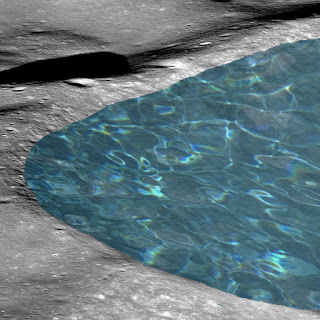Last week, I attended the NASALunar Science Institute's Workshop without Walls
on Lunar Volatiles. The really interesting thing about this workshop is that it
was conducted completely on line. Presenters gave their talks using a web cam,
and they and their slides were displayed in a split screen through a regular
web browser. This meant the talks could be followed by anyone with a computer
and internet access. I watched from home, but some people gathered in
designated meeting hubs, to get more of a communal experience. Participants
could also interact with the speakers or other participants through chat windows. The best part of this kind of virtual
workshop, is that all the talks were archived and are now available through the
site's Schedule web
page. I would encourage you to go check
it out!
 |
| There is a lot of water on the Moon, but not this much! Image Credit: NASA/GSFC/Arizona State University and Irene Antonenko |
In the very first talk of the workshop, Dr. Larry Taylor from the University
of Tennessee summed up the exciting turn-around that has happened in the study
of lunar volatiles over the past few years.
Up until relatively recently, we thought the Moon was "bone
dry", but now we know it is quite "wet" in a variety of ways.
Back in the Apollo era, the
accepted wisdom was that the Moon contained effectively no water or other major
volatiles, not only on the surface, but in the rocks themselves too. It was
believed that all the volatiles would have evapourated during the Moon's very
hot formation and any volatiles added later on wouldn't have stayed on the
surface very long - volatiles being relatively light would have easily escaped
the pull of the Moon's weak gravity. So, the Moon must be very dry.
This belief was so entrenched in
the 1970's that when rust was found in samples brought back by the Apollo missions, it was determined that water from
the Earth must have contaminated the sample boxes and allowed the iron-rich
lunar materials to rust. Dr. Taylor
himself pleads guilty to pushing this interpretation and confesses that "his
big mouth" convinced people that this was just terrestrial contamination.
| This data from Chandrayaan-1's Moon Mineralogy Mapper instrument shows the distribution of various materials on the Moon. Small amounts of water and OH molecules show up as blue, and are clearly concentrated at the poles, where low temperatures are more likely to trap them. For more information on this image, check out the Moon Mineralogy Mapper Exploration Resources page. Image Credit: NASA/ISRO/Brown Univ. |
However, in 2009 it was finally
realized that there was water on the Moon, when data from the Clementine, Lunar
Prospector, and Chandrayaan-1 orbital missions all showed evidence for its
presence. With so much data pointing to
water on the Moon, the reality could no longer be ignored. Dr. Taylor himself admits that he has
completely changed his position on the topic!
With all this orbital evidence for
water, a number of researchers took another look at the Apollo lunar samples. Analyzing
basalt rocks with techniques that were not available in the 70's, they found a significant
amount of water within the minerals that make up the rocks, in some cases as much
as 1% of sampled minerals.
The important thing about basalt
is that it is solidified magma. As such, basalts provide a sample of the lunar
interior, from where the magma originates. So, the presence of water in the
basalt rocks means that there must have been water in the lunar interior at the
time these basalts formed on the Moon's surface.
 |
|
A thin slice of Apollo basalt sample 14053 viewed magnified
in cross-polarized light (xpl). Each type of mineral interacts differently with
the polarized light, producing the various colours we see.
You can explore this thin section for yourself at The Open University-NASA Virtual Microscope.
Image Credit: NASA/Open
Univ.
|
So, the questions now is, where
did this water originally come from? If the Moon formed when a Mars-sized
object crashed into the early Earth, the ejected debris that formed the Moon
really would have lost all its volatiles to space. One theory is that comets
that impacted into the Moon very early in its history could have delivered
enough water to seed the interior with the needed volatiles. The problem,
however, is that analyses of lunar water show that it is more similar to
asteroid and terrestrial water than water from comets. So, the water we see could not have come from
comets.
We know that currently water on
the surface is being replenished by impacts and solar wind. Even small
hypervelocity (~2-20 meters per second) impacts can crush atomic molecules,
breaking them up and leaving "dangling bonds" of oxygen (oxygen is a
major component of all rocks, and so is very plentiful). Hydrogen from the
solar wind then bonds to these available oxygen atoms, creating water. However,
this process works only on the surface, and can't account for water deep in the
lunar interior.
At the moment, we have no idea how
water from the Earth and asteroids got into the Moon's interior. A lot of work
still needs to be done to understand this aspect. But, the field is hopping,
with lots of renewed interest in a topic that was, until recently, thought to
be impossible. Stay tuned....
Source:
